

High Resolution Podcast. How and why organizations fail or succeed in adopting (their understanding of) design thinking. Design Thinking und Coaching. Mindset? Process? Method? A Comprehensive Descriptive Model for Design Thinking. Design thinking has become crucial for many activities in the business world as well as in other contexts.
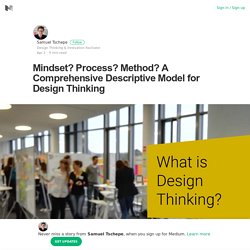
However, design thinking is still a rather nebulous phenomenon in literature as well as in practice. As Carlgren et al. (2016, 49) state: Curriculum Home Page. Welcome to the Curriculum Resources Home Page This is a collection of curriculum created by the K-12 Lab at the design school and teachers who are using design thinking in their schools.
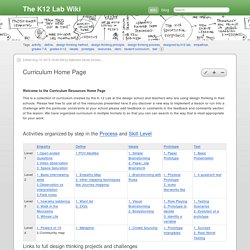
Please feel free to use all of the resources presented here.If you discover a new way to implement a lesson or run into a challenge with the particular constraints at your school please add feedback or comments in the feedback and comments section of the lesson. We have organized curriculum in multiple formats to so that you can can search in the way that is most appropriate for your work: Design Kit. Design method toolkit Design method toolkit for multidisciplinary design research, developed by MediaLAB Amsterdam. Workshop Übungen - Persona und Consumer Journey Entwicklung. SlideShare verwendet Cookies, um die Funktionalität und Leistungsfähigkeit der Webseite zu verbessern und Ihnen relevante Werbung bereitzustellen.

Wenn Sie diese Webseite weiter besuchen, erklären Sie sich mit der Verwendung von Cookies auf dieser Seite einverstanden. Lesen Sie bitte unsere Nutzervereinbarung und die Datenschutzrichtlinie. SlideShare verwendet Cookies, um die Funktionalität und Leistungsfähigkeit der Webseite zu verbessern und Ihnen relevante Werbung bereitzustellen. Wenn Sie diese Webseite weiter besuchen, erklären Sie sich mit der Verwendung von Cookies auf dieser Seite einverstanden. Lesen Sie bitte unsere unsere Datenschutzrichtlinie und die Nutzervereinbarung. Start Here. Hello and Welcome to UsabilityGeek, I’m Justin, the founder of this blog and I would like to personally thank you for stopping by!

If you are new to the user experience domain and you want to work your way through, starting from the basics and moving on to more advanced topics, then this page is for you! UsabilityGeek is all about sharing knowledge that bridges theory and academic research with practical and personal recommendations on how to deliver a great user experience. We invite contributions from guest authors so as to provide a hub for tips and insights from experts across the industry We strongly believe that to understand user experience one needs to have at least a basic knowledge of related (and seemingly unrelated) domains.
We’ve got lots of articles and I understand that the sheer thought of trying to figure out where to start is overwhelming. Enough said, let’s get started! Tele-TASK - tele-TASK Lecture: Design Thinking - Helping to Reinvent Enterprise Computing - Your online archive for high quality e-learning content. Prof.
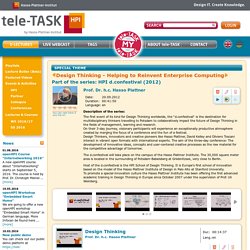
Dr. h.c. Hasso Plattner Description of the series: The first event of its kind for Design Thinking worldwide, the “d.confestival“ is the destination for multidisciplinary thinkers travelling to Potsdam to collaboratively impact the future of Design Thinking in the fields of management, learning and research.On their 3-day journey, visionary participants will experience an exceptionally productive atmosphere created by merging the focus of a conference and the fun of a festival.Design Thinkers, innovators and creative pioneers like Hasso Plattner, David Kelley and Oliviero Toscani interact in vibrant open formats with international experts.
The aim of the three-day conference: The development of innovative ideas, concepts and user-centered creative processes as the raw material for the competitive advantage of tomorrow. The Wallet Project. The Wallet Project is 90-minute (plus debrief) fast-paced project though a full design cycle.

Students pair up, show and tell each other about their wallets, ideate, and make a new solution that is "useful and meaningful" to their partner. >> Note: a topic variation for the project is the "Gift-Giving Experience". You can find the materials for that project on the page The Gift-Giving Project. And you can figure out which topic might be better for you on this page: Project Topic: Wallet, Gift-Giving, or other. Design Thinking Projects and Challenges. Design Thinking Builds Strong Teams. No company can succeed on the brainpower of one person.

Teams are the foundation of a successful workplace. But working in teams can have a fairly large cost: members must spend time building common ground — that is, a body of common knowledge, assumptions, vocabulary, and cultural practices. In strong teams, the common ground has already been established and the overhead of communication is outweighed by the benefits of collaboration. BVT Multimedia Communications. CTA - Blog. Design Thinking with SAP. Design Thinking: New Product Development Essentials from the PDMA - Michael G. Luchs, Scott Swan, Abbie Griffin.
KQED Public Media for Northern CA. How to Apply Design Thinking in Class, Step By Step. By Anne Stevens For educators ready to try the idea of design thinking, you’ll be glad to know it does not require extensive transformation of your classroom. That said, it can be a transformative experience for all involved. Here, we try to answer your questions about integrating different components of a design learning experience into familiar, pre-existing scenarios that play out in every school. Can my classroom become a space of possibility? Design Thinking, Deconstructed. What Does ‘Design Thinking’ Look Like in School? Getty Images Design thinking can seem a bit abstract to teachers.
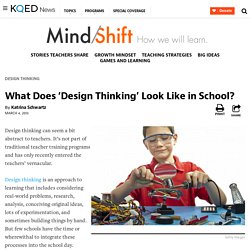
It’s not part of traditional teacher training programs and has only recently entered the teachers’ vernacular. Design thinking is an approach to learning that includes considering real-world problems, research, analysis, conceiving original ideas, lots of experimentation, and sometimes building things by hand. But few schools have the time or wherewithal to integrate these processes into the school day. But at the Nueva School in Hillsborough, Calif., a small, private school for grades K-8, design thinking is part of every class and subject, and has been integrated throughout the curriculum with support from a dedicated Innovation Lab or the iLab.
DESIGN THINKING. 2010%20Facilitator%20Toolkit%20WEB. How and why organizations fail or succeed in adopting (their understanding of) design thinking. Ten Years of Support for Design Thinking – An Interview with Hasso Plattner. Design thinking is getting more and more popular.
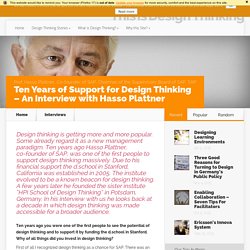
Some already regard it as a new management paradigm. Ten years ago Hasso Plattner, co-founder of SAP, was one of the first people to support design thinking massively. Due to his financial support the d.school in Stanford, California was established in 2005. Why Design Thinking Can Contribute to a Growing Business - Designorate. Design thinking is defined by Tim Brown, CEO of IDEO, as “a discipline that uses the designer’s sensibility and methods to match people’s needs with what is technologically feasible and what a viable business strategy can convert into customer value and market opportunity.”

Design thinking aims to achieve innovation and solve problems while putting the end consumer in the heart of the process. It is adopted by companies in order to increase the understanding of their consumers and the organization’s ability to create new ideas and achieve disruptive innovation. It encourages the building of an iterative process where ongoing improvement of the product or service is part of the production process.
In a recent article by McKinsey & Company, “Building a design-driven culture,” Kilian, Sarrazin, and Yeon highlighted that companies need to embed experience design in the organization in order to engage with their consumers. Designorate - Design thinking, management and education. 'Design Thinking' for a Better You. ZOE Grots Creuznacher 2 12. The Deep Dive - Part 3 of 3. The Deep Dive - Part 2 of 3. The Deep Dive - Part 1 of 3. IDEO Workshop Part Four: Prototyping. IDEO Workshop Part Three: Brainstorm. IDEO Workshop Part Two: Synthesis. IDEO Workshop Part One: Observations. Design Thinking workshop with Justin Ferrell of Stanford d. School at The Irish Times.
ZOE Grots Creuznacher 2 12. Design Thinking – Mit Methode zur Innovation. In keiner Branche werden so viele Produkte entwickelt, die bis zum Markstart von keinem Nutzer gesehen wurden, wie in der IT-Branche. Um eine Software, Web-App oder App für's Smartphone zu entwickeln, braucht man vor allen Dingen erst mal nur eins: einen Programmierer. Dem gibt man dann irgendein Produktkonzept, das ein vermeintliches Problem lösen soll. Und genau das passiert dann auch oft: irgendein Produkt, das irgendein Problem löst – nur nicht das der Nutzer. Das liegt vor allem daran, dass das Problem der Nutzer gar nicht bekannt ist, oder man schlichtweg von anderen Problemstellungen ausgeht als der Nutzer.
Ideo's David Kelley on "Design Thinking" The smell of ramen noodles wafts over the Stanford d.school classroom as David Kelley settles into an oversize red leather armchair for a fireside chat with new students. It's 80 degrees and sunny outside in Palo Alto, and as the flames flicker merrily on the big computer screen behind him, Kelley, founder of both the d.school and the global design consultancy Ideo, introduces his grad students to what "design thinking" — the methodology he made famous and the motivating idea behind the school — is all about. Design Thinking is About Doing. Information Literacy by Design [Thinking]
Design thinking. It’s that abstract concept that you’ve probably heard about in association with makerspaces. It’s also a big buzzword in the world of education reform. I’m tempted to define it as ‘that thing you do when you design something.’ That’s about as clear as mud. Educator as a Design Thinker. 45 Design Thinking Resources for Educators.
How Design Thinking Transformed Airbnb from a Failing Startup to a Billion Dollar Business. Inside Apple’s Internal Training Program. CUPERTINO, Calif. — Apple may well be the only tech company on the planet that would dare compare itself to Picasso. In a class at the company’s internal training program, the so-called Apple University, the instructor likened the 11 lithographs that make up Picasso’s “The Bull” to the way Apple builds its smartphones and other devices.
The idea: Apple designers strive for simplicity just as Picasso eliminated details to create a great work of art. Steven P. Jobs established Apple University as a way to inculcate employees into Apple’s business culture and educate them about its history, particularly as the company grew and the tech business changed. Courses are not required, only recommended, but getting new employees to enroll is rarely a problem. Although many companies have such internal programs, sometimes referred to as indoctrination, Apple’s version is a topic of speculation and fascination in the tech world. Unlike many corporations, Apple runs its training in-house, year round. METHODCARDS2010pagenumbers.pptx. Design Thinking for Educators. News - Articles. Use our methods. DP0 (Design Project Zero) is a 90-minute (including debrief) fast-paced project though a full design cycle. Students pair up to interview each other, create a point-of-view, ideate, and make a new solution that is “useful and meaningful” to their partner.
Two versions of DP0 are “The Wallet Project” and “The Gift-Giving Project”. They have the similar format, only the topic is different. The original DP0 The Wallet Project was created for the d.school’s very first course in 2004 and the project starts with students looking at the content of their partner’s wallet or purse (and goes on to ask every student to design something for their partner). Another DP0 topic is The Gift-Giving Project where students are asked to redesign how their partner gives gifts.
Get the materials to facilitate the activity for a group yourself here. Or play the Crash Course (video facilitation that leads the group) here. Design Thinking for Educators. How to Build Students' Creative Confidence. I recently visited a school district where teachers are experimenting with Genius Hour. Sometimes called 20 percent time after the Google practice of reserving a day a week for individual research, Genius Hour offers students a regular time each week to tackle projects that reflect their personal interests and passions. (Blogger A.J. Juliani explains the reasoning behind 20 percent time.)
When I stopped by an elementary class during Genius Hour, I found students with no shortage of project ideas -- from rocketry to the history of ceramics. Their main challenge was finding enough time in the coming weeks to get to all the wonderful questions they were eager to explore. The 7 Values That Drive IDEO. Our point of view. Students come to the d.school with an intense curiosity, a deep affinity for other people, and the desire to gain an understanding beyond their own experience. They come from every school on campus, and beyond. Instead of working on different pieces of the same project, they navigate each step in the innovation process together, leveraging their differences as a kind of creative engine.